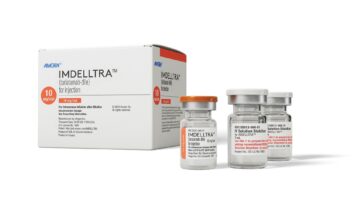Ever forget the difference between an IND, a Phase I and Phase II trial? The difference between protein expression and gene expression profiling? The National Cancer Institute has a nifty tutorial that breaks down the development process of new, targeted therapies in cancer.
It’s a good resource for anyone – be it you, a friend, a colleague, a client – who needs a refresher course on the basics of personalized medicine in cancer therapy. There’s a video, too: How are Targeted Therapies Linked to Personalized Medicine?
The targeted therapy approval process isn’t particularly different from your standard regulatory rigmarole. But in brief, this is how the magic’s done:

Using Informed Awareness to Transform Care Coordination and Improve the Clinical and Patient Experience
This eBook, in collaboration with Care Logistics, details how hospitals and health systems can facilitate more effective decision-making by operationalizing elevated awareness.
1. Identify and validate a target.
Scientists are finding new ways to find cancer targets – that is, find the chinks in a cancer cell’s armor that reveal its replication process – so they can be studied and disarmed with a drug. For example, some survey whole chromosomes for abnormalities with a technique called comparative genomic hybridization. Others scout out changes in either gene expression levels – gene expression profiling – or in protein expression levels, called proteomics.
After this first step, researchers have to validate the target by studying it in animal models, in large panels of cancerous tissues from patient biopsies and in cancer cell lines. They have to show that they understand how the disease pathway works in cancer cells.
2. Preparing for clinical trials – that is, finding a drug.
Researchers now can start thinking about the best way to begin studying this target – and potential treatment options – in humans. That is, they find a drug. They then test it in petri dishes and in animals to show the drug interferes with a cancer’s progress without too much damage to healthy tissue. If all passes muster, scientists identify an appropriate patient population.
3. Exploratory Investigational New Drug (IND) Trials
This prelim testing round allows researchers to give a small pool of volunteer patients a small amount of an investigational drug, to see whether it can reach and impact a target. This clues researchers in to whether they’re on the right track, or need to hit the drawing boards to make modifications to their drug. The results aren’t really indicative of whether the drug will treat a disease, because the dosage, sample size and time administered is very low.
4. Phase I Clinical Trial – Testing safety
These small trials typically enroll 15 to 30 patients. They determine appropriate dosage, and learn how patients metabolize the drug. Phase I trials are also the first real opportunity to identify any negative effects from the drug.
5. Phase II Clinical Trial – Testing efficacy
The patient population grows here to about 100, and usually consists of patients that aren’t responding to approved therapies for their cancer. While the drug’s safety profile continues to be evaluated, its effectiveness is more carefully observed by researchers.
6. Phase III Clinical Trial – Testing efficacy in a large population
These studies can be from 100 patients to several thousands, largely depending on the commonality of the disease. These costly trials really show whether a drug’s benefits can outweigh its risks. This trial is the most critical step, much of the time, for FDA approval.
7. Phase IV Clinical Trial – Long-term effects
Some drugs are evaluated even after approval and commercialization – their effects are continually monitored in large numbers of patients in what are called open-label studies.
The number of FDA-approved targeted therapies is growing:
About a dozen drugs are approved as targeted cancer therapies, including the popular Avastin and Rituxan, and the list is growing as more and more early- and mid-stage biotechs enter this game.














